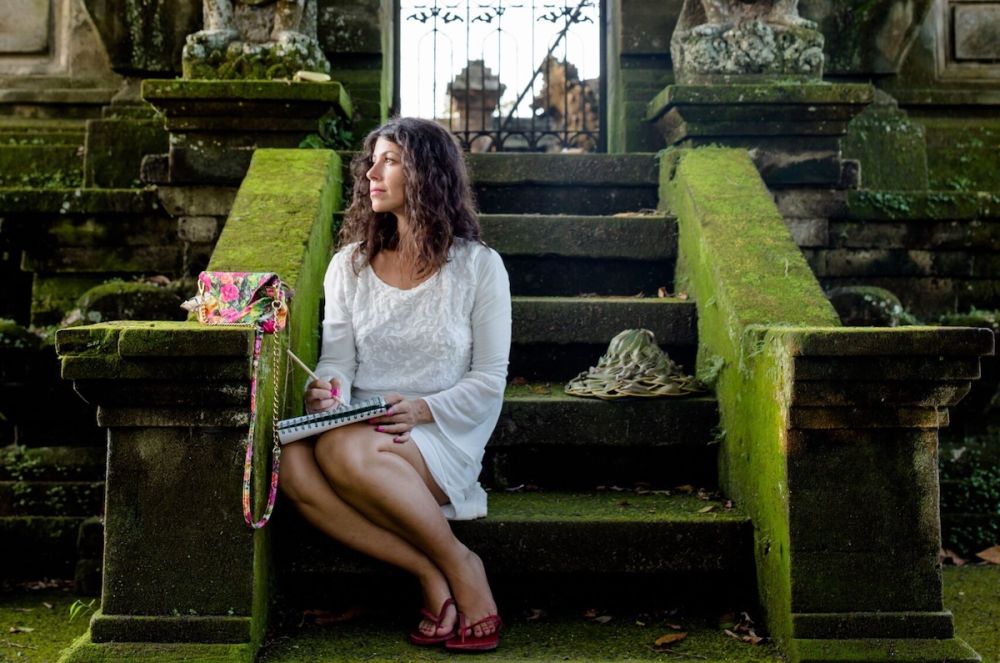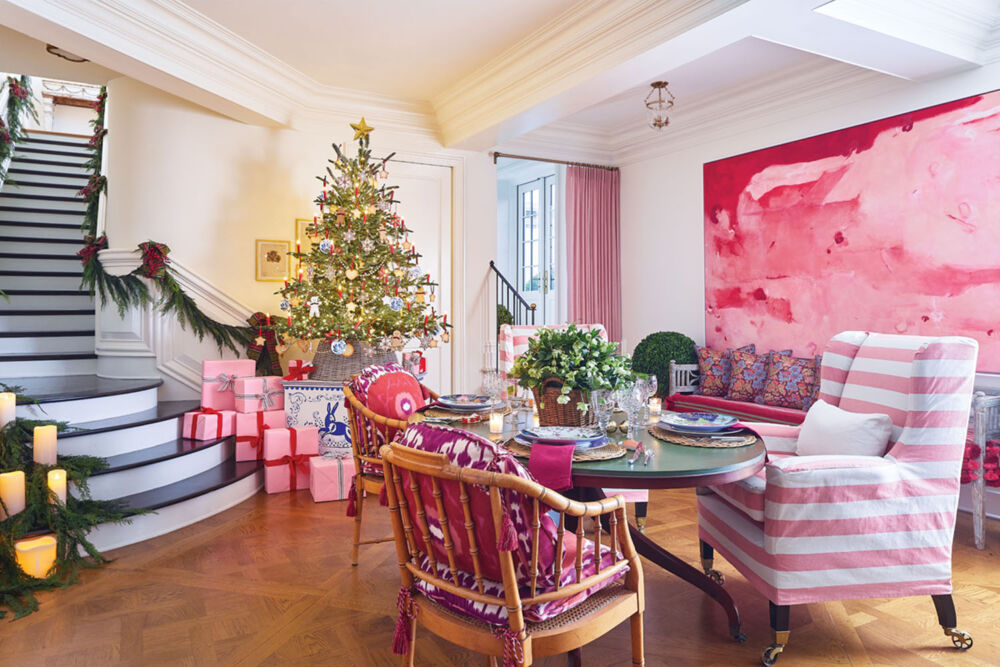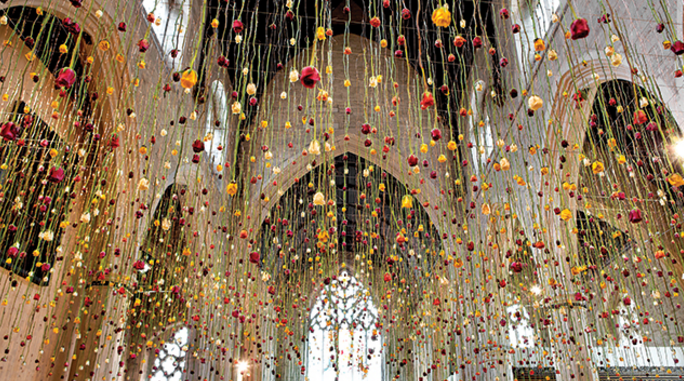
In Rebecca Louise Law’s 3,000-flower installation in London’s Garden Museum, roses rained down from the cathedral ceiling. Photo courtesy of Rebecca Louise Law / © Nicola Tree
On Sundays, the Columbia Road Flower Market fills the streets and scents the air with roses, lilies, and peonies. By design, floral artist Rebecca Louise Law can easily take it all in from her terraced flat and gallery, set in the heart of the bustling East London avenue. Though this edgy neighborhood is miles from the rolling hamlet where she grew up, the common denominator is Law’s intentional proximity to flowers. When it comes to her lush artwork, flowers are literally over her head.
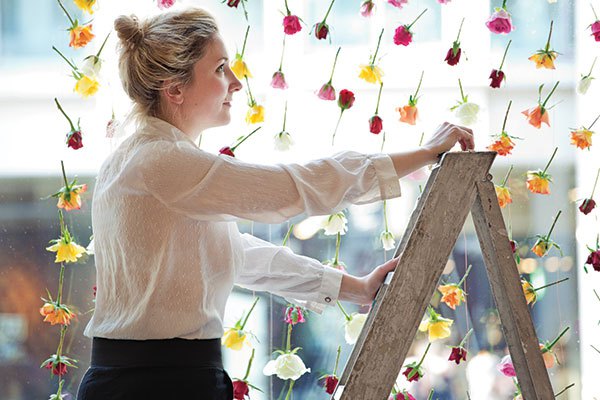
Artist Rebecca Louise Law completes a floral wall in the window of her London gallery. | Photo courtesy of Rebecca Louise Law
Suspended floral gardens are Law’s calling card. The large-scale installations, poetically nicknamed flower skies, are to be marveled at for the sheer immensity of blooms, often reaching the thousands. “My inspiration always comes back to a field of flowers and placing that impact in an urban environment,” says Law, who grew up outside Cambridge in a village clear of freeways and rife with fields. “As a child, we had acres and acres to run free through the wildflowers, forests, and streams. I suppose I always wanted other people to get a part of that freedom in nature.”
Law’s three-dimensional—four, if you consider the fragrance factor—and interactive works are breathtaking nods to the boundlessness of nature. Take the floating meadow made up of 4,600 blooms she created inside London’s Garden Museum at the Fashion & Gardens exhibition; or the mistletoe chandelier she cascaded down the spiral staircase of the Tiffany & Co. London flagship location last Christmas; and, with a touch of theater, the unforgettable 6,200 blue hydrangeas she rained down from copper wire at the Maecenas Dinner in Brussels. These handcrafted flights of fancy often call for 50 extra hands, including Law’s dutiful husband Andrew, to assemble all of its ephemeral parts within the confines of a single day. “I’m always facing the challenge of trying to make the material last longer, so I design them to be able to dry,” says Law.
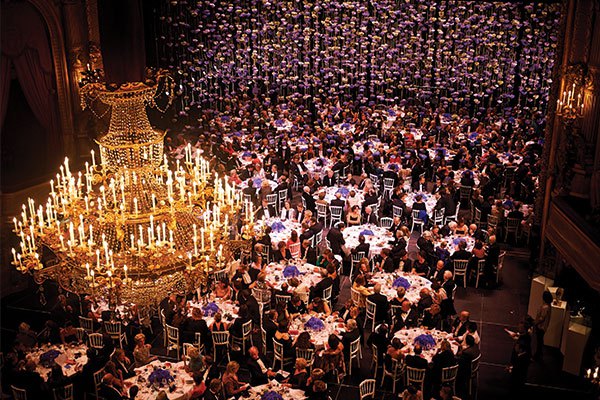
Law dramatically raised 6,200 indigo hydrangeas over guests dining inside the Théâtre Royal de la Monnaie in Brussels. | Photo by Violaine Le Hardÿ & Arnaud Ostrowski
It isn’t difficult to understand why Law has built her life around flowers. First, there are her family roots: “I remember my parents would dry flowers in our attic,” recounts the vintage-clad artist who prefers her golden locks elegantly upswept. “Art and gardening were a massive part of my family; my grandma and auntie are artists and my dad is a gardener.” Then, there’s the artistry: Though trained in floral design at the prestigious McQueens florist, where she rose to senior designer, she first studied fine art at Newcastle University. “I’ve always been passionate about flowers, but it was in school that I first looked at flowers as a material that could be plied. The combination of art with floristry and gardening culminated into where I am today,” she says.
Having sourced a botanical encyclopedia worth of floral varieties, from chrysanthemums to zinnias, for her artwork, Law confesses that roses are her favorite. “Roses are the foundation of my work, in terms of drying and being very reliable. If it’s a tricky environment, then I will always fall back on roses.” Indeed, her shop window, often the second act for some installations, is currently home to an oversized picture frame made entirely of dried roses. “I want people to reevaluate flowers and to see the value in them through every stage, from seed to decay,” says Law, whose latest creations further that mission. Adorning the white walls of her Victorian-feeling gallery are her decidedly small-scale riffs on Dutch still lifes—moody compositions of fruit and flowers encased in glass cabinets. “I’ve always loved the Dutch masters, playing with scale, and any eclectic work of decay,” says Law.
On the other end of the design spectrum and of town, London Fashion Week is approaching and Law will likely lend her signature floral alchemy to top houses, as she’s done before for Jimmy Choo with English wildflowers dripping from the rafters, or a bed of blooms for Max Mara. Perhaps the most memorable, Law remembers wistfully, is an early project for Hermès, which stands out, not for the blooms, but for the carte blanche the Parisian house granted: “It was the first time I had a client say, ‘You tell us.’ Having that respect as an artist was paramount.”
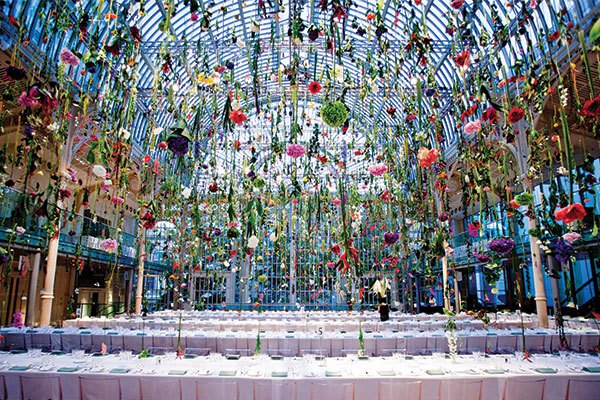
Garden blooms dangled from the glass ceiling of the Floral Hall inside the London Royal Opera House for the Ballet and Banquet affair hosted by Hermès. | Photo © ROH / Andrej Uspenski 2011
By Alison Miller



